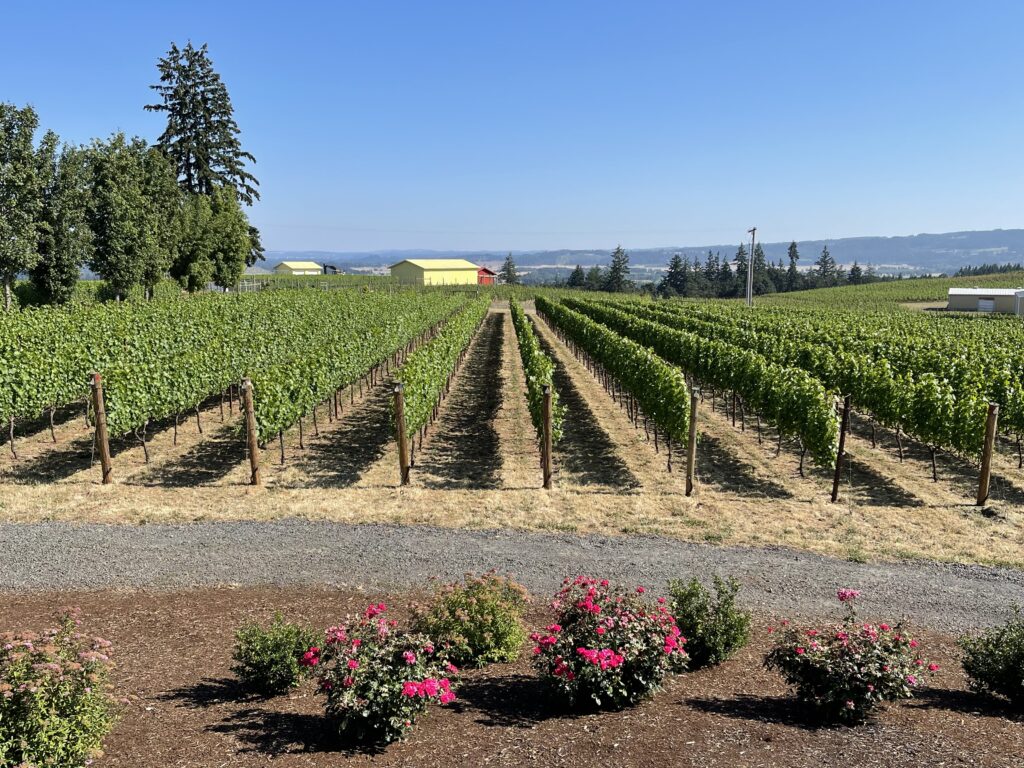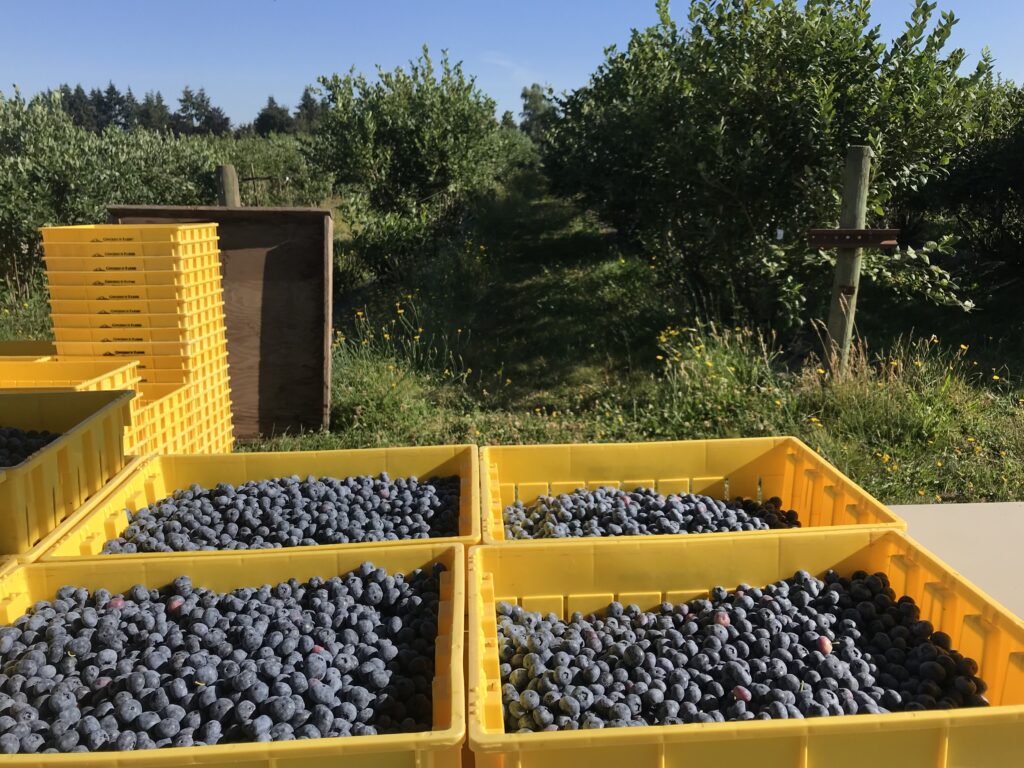Between 2001 and 2016, 11 million acres of farmland in the United States were developed, with 4.1 million acres converted to urban and highly developed land uses and almost 7 million acres converted to low-density residential use. The 2017 U.S. Department of Agriculture (USDA) Agricultural Census revealed that from 2012 to 2017, the amount of farmland in the United States decreased by over 14 million acres. This trend is replicated in many states, even Oregon, where the land use system was specifically designed to protect the state’s natural resources. Agriculture is one of Oregon’s most economically influential industries, contributing 13.2% of all Oregon sales, 10.2% of the net state product, and 13.8% of full and part-time employment in the state. Therefore, the central question in Oregon agriculture’s future is: are the land use laws as they currently stand enough to protect Oregon farmland and preserve Oregon’s farming communities?

Vineyard in Aurora, Oregon, Credit: Bernadine Strik
Oregon’s trailblazing comprehensive land use planning system was enacted in 1973, when the state legislature passed the Land Conservation and Development Act. The Act was primarily a response to rapid population growth and unanticipated urban sprawl into forest and farmland. The Act created the Department of Land Conservation and Development, which had the responsibility of strategically planning urban and suburban development to ensure livability and protect forestland, farmland, and natural resources. At the core of Oregon’s land use planning system is the designation of urban growth boundaries (UGBs), which concentrate new development within urban centers. Zones outside these UGBs are restricted to farming, forestry and other rural land uses. While the Act does not prohibit development on farmland, it does limit the speed, location, and densities of development in these restricted areas.
Oregon’s land use laws specifically state as a goal that “agricultural lands shall be preserved and maintained for farm use”. This goal, the third goal of Oregon’s land use system, requires that all suitable agricultural land be zoned for exclusive farm use, severely limiting the potential for residential development on these lands.
Research indicates that Oregon’s efforts to curb urban sprawl in the 1970s have yielded significant results in the decades since. A land-use model projecting Oregon’s farmland composition with and without the land use planning system in effect showed a statistically significant impact of the law on farmland conversion. The model’s distributions of land use with and without the planning system indicate that by 1994, the land use law had protected nearly 225,000 acres of farmland from low-density development and over 74,000 acres from higher-density development.
States like Oregon and Washington have particularly strong policies to address threats to agricultural land, according to Farms Under Threat: The State of the States report released by the American Farmland Trust. Between 1982 and 2017, farmland shrunk by almost 707,000 acres in Oregon and over 1.3 million acres in Washington. That amount is equal to about 17% of the initial farmland area in 1982 in both states. Colorado, by contrast, lost about 2.5 million acres in the same period to other uses, which represents a shrinkage of 24%. Texas also lost nearly 30% of its farmland from 1982 to 2017. According to the 2017 National Resources Inventory Summary Report, about one-third of the land lost is used explicitly for development. While Oregon and Washington were identified as having strong agricultural land use policies and low agricultural vulnerability in the American Farmland Trust report, Colorado and Texas were amongst the states with less effective policies and higher vulnerability to farmland loss. Therefore, the land use policies effective in Oregon and Washington appear to have provided an important defense against the prominent trend of farmland conversion in other states.

Organic blueberry harvest in Aurora, Oregon, Credit: Bernadine Strik
Though Oregon has comparatively low farmland loss, what land is converted generally has exceptionally high agricultural value. Of the land developed between 2001 and 2016, almost one-third was considered “Nationally Significant,” meaning it is particularly productive, versatile, and resilient. Many of the areas where urban intrusion is most significant are agricultural hotspots like the Willamette Valley and Deschutes counties, where prime farmland abuts urban areas. Therefore, while the overall loss of land may be smaller, the specific area lost to development is of higher value than agricultural regions in other parts of the state.
Oregon’s comprehensive land use planning system has undoubtedly decreased urban intrusion into agricultural areas and slowed farmland conversion. However, current land use laws have been unable to preserve some of the most valuable farmland in the state and the industry remains vulnerable. In many of the most fertile regions of the state, like the Willamette Valley and the Wallowas, community character and culture are constructed around the practice of farming. As the industry becomes increasingly vulnerable, more farmers sell their land, fewer generational farms are passed down to younger generations, and community culture formed around agriculture diminishes. While Oregon’s land use laws represent an important first step for many western states with greater threats to agricultural land, there remain measures that must be taken to preserve the most valuable farmland and ensure security to younger farmers so that family farms are protected. Farms throughout the West are an important part of the region’s history, economy, and culture. Strengthening land use laws, even in states like Oregon with robust land use planning systems, can address the cultural and economic implications of urbanization and suburbanization of America’s farmland.

Shannon Bell, Western Resource Fellow and Research Assistant | Shannon is a Master of Environmental Management candidate at the Yale School of the Environment specializing in environmental policy analysis. She is particularly interested in collaborative policymaking and nature-based climate solutions in the Pacific Northwest, especially in her home state of Oregon. Shannon was inspired to return to the landscape where she was born and raised by both her education in environmental science and climate policy as well as her intimate connection with the diverse forest and highland desert ecosystems. She came to Yale after graduating from the University of British Columbia with a B.S. in Honors Environmental Science. See what Shannon has been up to. | Blog
